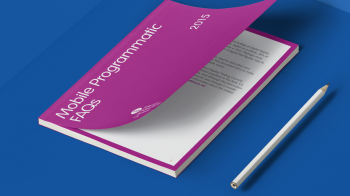The Future of the Super Bowl Ad
Andy McNab
Andy McNab, UK Managing Director at Rocket Fuel looks at what marketers can learn from the growth and evolution of Super Bowl advertising.
Whilst the Denver Broncos and Carolina Panthers battle it out on the field on Sunday in Super Bowl 50, the biggest brands across the world will put aside their better instincts about data-savvy consumer segmentation and spend big for a TV appearance during the game. It is certainly a meaningful moment in the TV calendar for advertisers. But what can we learn from the growth and evolution of Super Bowl advertising? What will Super Bowl ads look like in 2020?
The undercurrent driving changes in TV advertising is the growth of programmatic marketing. Global programmatic ad spend will reach $37bn by 2019. This will mean the dawn of programmatic TV, which by some accounts is projected to rise from $1B in 2016 to $12B in 2020. Despite the dramatic growth of programmatic advertising, there hasn't yet been a creative experience for an advertiser that's quite like "the couch"—one that provides the ability to serve the immersive sound and inspiring imagery of rich media on a big screen to an engaged, captivated audience. But as the link between traditional TV and digital devices strengthens, the TV becomes a powerful channel to deliver more targeted and relevant messages; particularly as the ability to have a better understanding of consumers increases, based on their mobile and desktop device activities.
The opportunities for programmatic television when it comes to Super Bowl are too great to ignore and industry watchers are predicting that the Super Bowl ad will undergo a dramatic transformation as the digital advertising tools that have enabled an unprecedented degree of targeting and measurement become available for traditional TV ads. With the ability to sync linear television to individuals in a household, advertisers have an opportunity to deliver tailored Super Bowl messages, designed to influence consumers toward a desired action. For example, based on a person’s browsing activity, marketers can learn whether a consumer is in the market for a new car and in the right demographic for a luxury car.
Toyota’s Super Bowl ad for the Rav4, delivered into the household of a single family home, may have dramatically different creative than the ad streamed into an apartment that is home to recent graduates. Cross-device digital advertising can also come into play on Game Day, as well. Toyota may target a mother “second screening” on her tablet with a message of safety. Whereas, her 18 year old son, Tweeting about the game on his mobile, may receive an ad touting independence and adventure.
Not only that, television will be an input for greater digital marketing programs that inform and optimise other channels, creating a feedback loop. With a real-time connection to the web via set-top boxes, personal devices, or even connected glasses, consumers will be able to choose the ads they like via a "click" such as a button or voice command ("Cool ad!"). Advertisers will then be able to learn which Super Bowl ads individuals like, providing a more personalised and valuable experience to both the viewer and the advertiser.
As people and objects continue to coalesce and the "Internet of Things" becomes an increasingly tangible concept, marketing in the moment—regardless of time, location, and device—will be crucially important. If a marketer knows with whom they are interacting via a rich set of attributes that describe them—and to which ads that consumer did and did not respond—it can vastly increase the precision of its media, and thus, optimise its spend. Whether it's on a TV, a smartwatch, a billboard, or even a refrigerator, anywhere there is or will be a screen represents an opportunity for a brand's story to transcend both the digital and real-world experiences of the most valuable consumers.
Whatever the future holds, one thing is clear: the marketers that are best at creating a consistent, personal, and compelling consumer journey will be the ones that thrive, particularly during moments like Super Bowl. Even if 20 years from now, consumers are wearing data-crunching smart socks while watching Super Bowl games on their wearable devices aboard the family space station, the principles of making meaningful connections with them will not change.
Related content
Cross-industry Programmatic Taskforce announces mission & objectives
Learn moreAdform: RTB Trend Report Europe Q4 2014
Learn moreTubeMogul: A UK advertisers guide to programmatic TV
Learn moreMobile Programmatic FAQs
Learn more
Rediscover the joy of digital advertising
Champion connections instead of clicks. Capture audiences' imaginations, not just their attention. Boldly find your own beat instead of letting tech set the pace. It’s time to rediscover the joy of digital.



